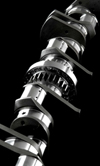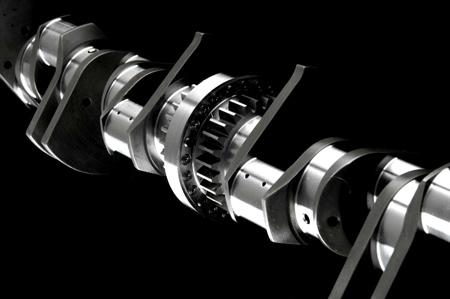Is nitriding the only option?
 The crankshaft lies at the heart of the fundamental mechanical system in the vast majority of race engines. Only rotary race engines don't have what we might call a crankshaft, although other mechanisms exist and which have been tested to turn reciprocating motion into rotary motion. Conventional wisdom has it that our steel race crankshafts are nitrided, almost without exception. An earlier article by Tom Sharp (1), posted in 2009, pointed to the fact that induction hardening is used occasionally on race crankshafts, although it is more suited to larger quantities. Induction-hardened crankshafts are common in production engines.
The crankshaft lies at the heart of the fundamental mechanical system in the vast majority of race engines. Only rotary race engines don't have what we might call a crankshaft, although other mechanisms exist and which have been tested to turn reciprocating motion into rotary motion. Conventional wisdom has it that our steel race crankshafts are nitrided, almost without exception. An earlier article by Tom Sharp (1), posted in 2009, pointed to the fact that induction hardening is used occasionally on race crankshafts, although it is more suited to larger quantities. Induction-hardened crankshafts are common in production engines.
Sharp's article, and the preceding one (2), discuss the reasons for choosing induction hardening in preference to nitriding. In this case, it was felt that induction hardening would be better suited to a roller bearing crankshaft, although nitrided crankshafts have run successfully with rolling element main bearings. Rolling element bearings impose considerable contact stresses on a crankshaft, and the maximum stress actually occurs below the surface, at a depth which can be beneath the diffusion zone of the nitriding. Subsurface fatigue can occur, leading to pitting and spalling, and soon to overall failure. A deeper hardened layer means that the material at the point of maximum subsurface stress is stronger and harder, and thus is more able to sustain a given amplitude of cyclic stress.
Carburised crankshafts fell out of general favour many years ago as nitriding became more popular. Compared to nitriding, carburising (also known as case hardening) requires much higher processing temperatures, and distortion can be a serious problem. Given the increasingly slender proportions of crankshafts in modern race engines, distortion can be a serious concern. In this process, carbon is diffused into the surface of a low-carbon steel to produce an outer layer which is very hard and wear-resistant. In common with nitriding, it offers a considerable amount of residual compressive stress at the surface, which is proven to improve endurance limit - 800 MPa of compressive stress at the surface is typical of a 0.25 mm deep carburising treatment (3).
Modern carburising methods that cause less distortion have been developed, and perhaps here is an alternative to nitrided crankshafts where roller bearings are used. Low-pressure carburising, also known as vacuum carburising, is becoming more popular, allowing some gears to dispense with post-carburising grinding.

In comparison to nitrided surfaces, carburised parts can be treated to have a much greater depth of hardening. The process is also shorter than typical nitriding processes and generally less costly.
Nitrocarburising is also used for race crankshafts, but not as widely as nitriding. The process is done at a slightly lower temperature than nitriding, and both carbon and nitrogen are diffused into the surface. It is capable of producing high levels of compressive residual stress but, in comparison to nitriding, the depth of the hardened layer and the depth of compressive stress are very much reduced. The hardened layer is so thin that it allows for no post-hardening material removal without seriously compromising the results of the hardening. Grinding is certainly out of the question if surface hardness and compressive residual stresses are to be preserved in the fillet radii of the crankshaft.
References
1. Sharp, T., "Which Surface Treatment Is Best?"
2. Sharp, T., "Which Hardening Method is Best?"
3. Tobie. T., et al, "Systematic Investigations on the Influence of Case Depth on the Pitting and Bending Strength of Case Carburized Gears", Gear Technology Magazine, July/August 2005
Fig. 1 - While nitriding dominates surface heat treatment methods for race crankshafts, there are alternatives (Courtesy of Arrow Precision)
Written by Wayne Ward